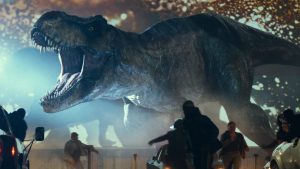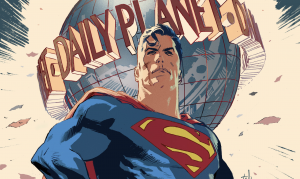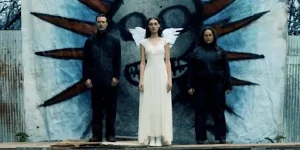
Star Trek has always been about boldly going, so it’s no surprise the franchise quickly moved beyond television sets. Even before the series jumped to the big screen, Star Trek expanded into the world of paperbacks, first with novelizations of Original Series and Animated Series episodes and then with original stories created for the page.
Starting with 1970’s Spock Must Die! by James Blish, the novels gave fans a chance to check in on the continuing missions of their favorite crews and characters. As of this writing, over 850 novels have made it to print, encompassing not only every series except Lower Decks but also spin-off series about totally new characters, such as Captain Calhoun of the USS Excalibur.
With so many options, the world of Trek books can get overwhelming. But these entries are a great place to start. Here are the best Star Trek novels ever written.
My Enemy, My Ally by Diane Duane (1984)
Ever since their first appearance in the TOS episode “Balance of Terror,” the Romulans have been among the best enemy aliens in the series, and no one has done more to flesh out this species than author Diane Duane, who penned the five-book Rihannsu series of novels that begins with My Enemy, My Ally.
My Enemy, My Ally follows Romulan Commander-General Ael t’Rllallieu on her daring mission to convince Kirk to help her attack a secret medical facility that is performing tests on Vulcans. Duane establishes the Romulans’ duplicitous culture, while also featuring Kirk at his strategic best.
How Much for Just the Planet? by John M. Ford (1987)
Not everyone loves it when Trek gets silly, but for those who like the lighter side of boldly going, there are books like How Much for Just the Planet? by John M. Ford. The book deals with some heavy concepts, with the Klingons and Starfleet coming to odds over Direidi, a planet rich in dilithium. Restricted from open warfare because of the limitations that the powerful Organians set in the episode “Errand of Mercy,” the two enemies must compete the Direidian way.
And that way is very silly. How Much for Just the Planet? plays like a musical comedy, forcing Kirk and Klingon Captain Kaden to go along with big theatrical numbers. The Klingon lore used by the book has been heavily-retconned in the years since, which might distract readers. But anyone who’s into singing competitions instead of phaser battles or intellectual debates won’t take this stuff too seriously anyway.
Vendetta by Peter David (1991)
Vendetta is the first book on this list written by Peter David, the comic book legend who also authored some of the best Trek books of all time. Vendetta feels like the Next Generation movie we never got, one that ties the Borg to the classic TOS episode “The Doomsday Machine,” while also fleshing out Guinan’s race, the El-Aurian.
When a spectral figure who first haunted Picard while at Starfleet Academy returns, the Enterprise discovers a planet-killing ship designed to take revenge against the Borg. Vendetta manages to tighten up Trek lore, including more information about the El-Aurian’s history with the Borg and the mystery of the ship in “The Doomsday Machine,” while managing a thrilling, character-driven tale.
Imzadi by Peter David (1992)
The romance between Commander Riker and Counselor Troi was a constant on TNG since the pilot episode. However, that relationship often fell by the wayside as writers had no idea about what to do with Troi, and wanted Riker to be the ladies’ man that many saw in Kirk. Leave it to Peter David to help flesh out that relationship with Imzadi, which goes back to the couple’s early days together.
David takes inspiration from one of the greatest Trek episodes of all time, “City on the Edge of Forever,” to send Riker across time to save a dying Troi. Along the way, readers see how Riker and Troi first fell passionately in love with one another on Betazed, establishing a love that not even disinterested writers could destroy.
Sarek by A.C. Crispin (1994)
Spock’s father Sarek looms large in Trek lore, so it’s surprising that he only had one appearance in TOS and one on TAS before showing up in several of the movies. The J.J. Abrams reboot and Star Trek: Discovery further developed Sarek, but that was after author A.C. Crispin wrote the definitive Sark novel.
Set shortly after Star Trek VI: The Undiscovered Country, Sarek finds Spock’s dad defending the Federation from the same conspiracy that tried to continue the war against the Klingons. Crispin gives readers a glimpse into unlikely relationship between Sarek and the human Amanda Grayson, giving us a more nuanced look at the love that gave birth to Spock. Sarek even checks in on another relative in Peter Kirk, son of George and the nephew of Captain Kirk.
The Return by William Shatner with Garfield and Judith Reeves-Stevens (1996)
As these books demonstrate, Captain Kirk’s life extends far beyond Star Trek television shows or movies. Yet, William Shatner couldn’t let Kirk’s story come to an end with his death in Star Trek: Generations. And so Shatner, along with Garfield Reeves-Stevens and Judith Reeves-Stevens, brought Kirk back in a series of books, dubbed The Shatnerverse because they take place in their own continuity.
Look, there’s no denying that the Shatnerverse books are exercises in vanity, the most obvious sort of self-insert fan-fiction. But as is so often the case with Shatner, the arrogance makes for an entertaining Kirk story. The Return features Kirk not only romancing a beautiful Romulan but also teaching Picard how to really fight the Borg. It’s at once absurd and enjoyable, just like Shatner himself.
Planet X by Michael Jan Friedman (1998)
Crazy crossovers are nothing new to comic books, even Trek comics. In those pages, Federation members rode the TARDIS from Doctor Who, wore Green Lantern power rings, and crossed paths with Marvel’s Merry Mutants, the X-Men. It’s those last set of meetings that inspired Planet X by Michael Jan Friedman.
Planet X picks up the threads from two X-Men/Star Trek comic books published by Marvel, the first of which involved the TOS crew and the TNG crew in the second. In Planet X, alternate reality shenanigans involving the Shi’ar bring the X-Men back onto the Enterprise-D, which gives Friedman a reason for some goofy fan moments. Worf and Wolverine rack up kills on a holodeck training program, while Storm and Picard have a pseudo romance (in which the former notes a striking similarity between the Captain and Professor X).
A Stitch in Time by Andrew J. Robinson (2000)
Deep Space Nine was packed with outstanding characters, none more so than the Cardassian Garak. Garak may have said he was just a tailor, plain and simple, but he carried secrets that made him far more dangerous. A Stitch in Time uncovers a lot (but not all!) of those secrets, and it comes from none other than Garak’s actor, Andrew J. Robinson.
Set shortly after the end of the Dominion War, A Stitch in Time operates as an epistolatory novel, consisting of letters sent from Garak to Dr. Bashir. Through the letters, Garak explains his childhood entry into Cardassia’s intelligence wing, the Obsidian Order, as well as his role in the resistance against the Founders’ occupation of his planet. Some readers might be shocked by Garak’s revelations, but as he taught Bashir, everything in his story is true, especially the lies.
The Eugenics Wars: The Rise and Fall of Khan Noonien Singh by Greg Cox (2001)
It’s easy to see why Nicholas Meyer keyed into “Space Seed” when doing research for Star Trek II: The Wrath of Khan. Portrayed by Ricardo Montalbán, Khan Noonien Singh presents the greatest challenge for Kirk. Beyond his great strength, Khan also has charm and brilliance, which explains the franchise’s insistence on bringing him back, again and again.
The Eugenics Wars series by Greg Cox provides the best look at Khan’s history, explaining how he rose to power and how his actions led to the worst war since World War III. Cox makes the surprising choice to tell the story from the perspective of agent Gary Seven and his partner Roberta Lincoln. Seven, Trekkies remember, was a time-traveler who encountered Kirk in the season two finale “Assignment: Earth,” which Gene Roddenberry hoped to spin off into a new series. To Cox’s credit, Seven’s inclusion doesn’t distract from Khan’s story, allowing the future conqueror shine.
Star Trek: Voyager Homecoming by Christie Golden (2003)
Star Trek: Voyager has overcome the initial resistance from fans in the ’90s and become a beloved series. Part of that change in opinion came from Voyager‘s finale, the excellent “Endgame.” With Homecoming, author Christie Golden takes “Endgame” one step further, showing the difficulties that the Voyager crew faces upon their return. Janeway might receive a hero’s welcome, but she comes with people that Starfleet looks upon with suspicion, especially the one-time Borg Seven of Nine and Maquis rebels such as Chakotay.
With Homecoming, Golden answers a lot of questions that still linger, even after Picard and Prodigy caught up with some of the characters. We see the way the Dominion War affected Starfleet’s concern for the missing Voyager as well as the desperation that forced them to accept Seven and the Maquis, albeit not without suspicion.
Titan: Taking Wing by Michael A. Martin and Andy Mangels (2005)
Before Picard or Lower Decks, the only place that Trekkies could find Riker at the helm of his own Starfleet ship, the Titan, was in print, namely a series of novels about Riker and his wife Troi coming into their own after their adventures with the Next Generation crew.
Taking Wing takes place after Star Trek: Nemesis, with the Romulan Star Empire still reeling from Shinzon’s attack. The Romulan Civil War offers a strategic advantage to Starfleet, but only if Riker can manage the difficult negotiations. Authors Michael A. Martin and Andy Mangels give Riker a diverse crew, which helps him distinguish his command style from that of Picard, while bringing back some old favorites, including Tuvok from Voyager.
The post The Best Star Trek Books Ever Written appeared first on Den of Geek.




